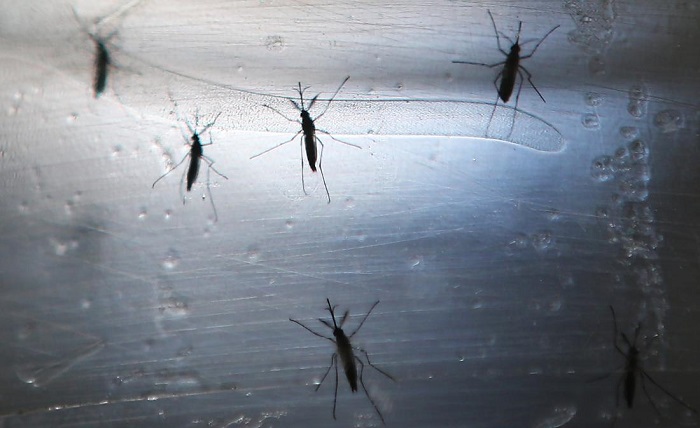Zika virus is a risk in border regions

Seven travel-related cases of Zika have been confirmed in Arizonans to date, including one in Pima County.
Zika is a type of flavivirus that is primarily transmitted by the bite of an infected mosquito.
Most people infected with the Zika virus don’t get sick, and once a person has been infected, federal health officials say he or she is likely to be protected from future infections.
Those who do fall ill have symptoms that may include fever, rash, joint pain and conjunctivitis (also known as pinkeye). But of immediate concern is that Zika is linked to a virus that causes birth defects among infants of infected mothers.
Zika virus infection during pregnancy can cause a serious birth defect called microcephaly, as well as other severe fetal brain defects, the U.S. Centers for Disease Control and Protection says.
The CDC is monitoring 287 women in the U.S. with lab evidence of Zika infection. As of June 23, the U.S. Zika Pregnancy Registry had reported seven live-born infants with birth defects and five pregnancy losses with birth defects.
In her testimony in D.C., Ernst noted that in the border area, poverty and crowded conditions are common, “and there is high mobility between the U.S. and Mexico where Zika transmission is already occurring.” In an interview last week she said sexual transmission of Zika in the borderlands is of particular concern.
Ernst, an associate professor of epidemiology and biostatistics in the UA’s Mel and Enid Zuckerman College of Public Health, told the Congressional committee that low-income neighborhoods with poor infrastructure and sanitation tend to have more garbage. From there, discarded containers can serve as habitat for the immature mosquitoes.
The risk of Zika along the U.S.-Mexico border has come to the attention of an environmental group in California that is trying to tackle the problem there.
In a wash alongside a recreational trail in the Tijuana River Regional Park near the international border in California is a foul-smelling pile of waste known to some locals as “the plug.”
It’s a combination of trash, raw sewage and mud that has run into San Diego County from Mexico during storms. Of immediate concern is that the trash flowing into the U.S. from Mexico includes lots of tires, a habitat for the Aedes mosquito.
“This is not acceptable, obviously,” said John Holder, border coordinator for the nonprofit conservation group Wildcoast, as he recently walked alongside “the plug” and pointed out tires, plastic bottles and Styrofoam.
“If we dug through this there would be layers of tires and trash. It goes on for at least 100 yards to the west, and from there it goes into the estuary and the ocean. “
The physical fence is not itself causing pollution problems in Mexico, Holder stressed, though the barrier makes cooperatively solving the problem more complicated. And the physical structure is arguably aggravating the problem.
A man-made culvert was built to carry storm runoff from Mexico to the U.S. when a canyon along the international border in Mexico called Smuggler’s Gulch was filled in by the U.S. Department of Homeland Security.
Oscar Romo, a University of California, San Diego, professor who has monitored Smuggler’s Gulch for two decades, says the culvert is taking storm runoff, including tires and other trash, faster and farther into the Tijuana River watershed, including the Tijuana River Regional Park.
On May 12 Wildcoast launched a collaborative project between Mexico and the U.S., supported by a $100,000 grant from CalRecycle. The objective is encouraging tire recycling in Mexico. Wildcoast officials say the project collected 2,500 tires in one day — all from the Mexican side of the border, in development areas that don’t have trash collection.
The project is being carried out through April 2017 in partnership with the state governments of Baja California and California with Wildcoast as the project coordinator.
The goal of the project is to collect and recycle approximately 50,000 waste tires in the Tijuana-San Diego border region from May 2016 to April 2017, and in the process reduce public health risks.
In an interview, Ernst said Arizona has the advantage of having a good working relationship with health partners in Sonora. There is constant communication about caseloads between both sides of the border, she said.
“It is a unique connection for the state of Arizona,” she said.
In addition, Ernst is working with the CDC and other partners on an app that will allow people to report on mosquito activity in their area, and find out information on confirmed Zika cases in Arizona, Texas and Florida.
The app is expected to be available to the public by the end of July. Mosquito activity and threats of mosquito-borne infection transmission are highest in July, August and September.
Ernst stressed that pregnant women are most at risk.
But protecting the most vulnerable people is up to everyone, including keeping empty lots in neighborhoods clear of trash, which can attract mosquitoes, she said.












































